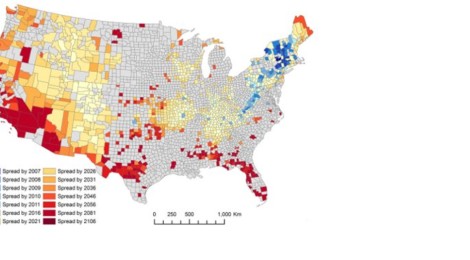
Spread of White-nose syndrome
Wildlife and plant diseases can reduce biodiversity, disrupt ecosystem services and threaten human health. Emerging pathogens have displayed a variety of spatial spread patterns due to differences in host ecology, including diffusive spread from an epicentre (West Nile virus), jump dispersal on a network (foot-and-mouth disease), or a combination of these (Sudden oak death). White-nose syndrome is a highly pathogenic infectious disease of bats currently spreading across North America. Understanding how bat ecology influences this spread is crucial to management of infected and vulnerable populations. In this study, we show that white-nose syndrome spread is not diffusive but rather mediated by patchily distributed habitat and large-scale gradients in winter climate. Simulations predict rapid expansion and infection of most counties with caves in the contiguous United States by winter 2105–2106. Our findings show the unique pattern of white-nose syndrome spread corresponds to ecological traits of the host and suggest hypotheses for transmission mechanisms acting at the local scale.
Related papers
- Maher, S.P, A.M. Kramer, J.T. Pulliam, M.A. Zokan, S.E. Bowden, H.D. Barton, K. Magori & J.M Drake. 2012. Spread of white-nose syndrome on a network regulated by geography and climate. Nature Communications 3:art1306. [pdf]
UGA press release [online]





